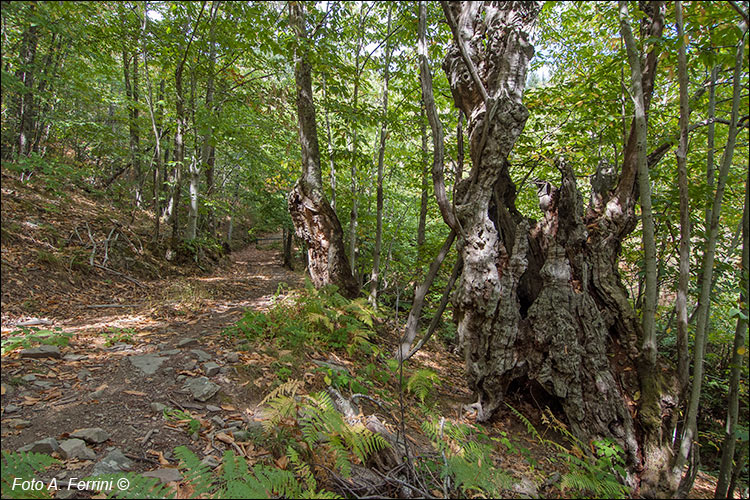Con Guido Monaco all'Abbazia di Santa Trinita
itinerario da Pontenano all'abbazia benedettina di Santa Trinita e al Varco di Anciolina
Italiano
STRADE E LUOGHI STORICI SUL PRATOMAGNO 17
Duecento metri dopo il Fosso delle Palmole troviamo, a destra del CAI 44, questo affascinante rudere di castagno secolare. Poche decine di metri più avanti la strada è chiusa da una sbarra, oltre non si può andare neanche con moto o veicoli fuoristrada. La zona a monte della strada, tra il Fosso delle Palmole (sopra la strada è denominato Fosso di Novelli) e il piccolo fosso dieci metri oltre la sbarra, è segnata nelle mappe come "Badia Vecchia" o "Badivecchia". In quest'area fu sicuramente fondata la prima Badia di Santa Trinita in Alpe, ma abbastanza più in alto rispetto al CAI 44 dove stiamo camminando adesso. Vi passeremo certamente molto più vicino tra quattro chilometri quando il CAI 32 ci farà attraversare la parte alta di "Badivecchia".
Two hundred meters after the Fosso delle Palmole we find, to the right of CAI 44, this fascinating ruin of a centuries-old chestnut tree. A few tens of meters further on the road is closed by a barrier, beyond which you cannot go even with motorbikes or off-road vehicles. The area upstream of the road, between the Fosso delle Palmole (above the road it is called Fosso di Novelli) and the small ditch ten meters beyond the barrier, is marked on the maps as "Badia Vecchia" or "Badivecchia". The first Badia di Santa Trinita in Alpe was certainly founded in this area, but quite a bit higher up than CAI 44 where we are walking now. We will certainly pass much closer to you in four kilometers when the CAI 32 will take us through the upper part of "Badivecchia".













































































